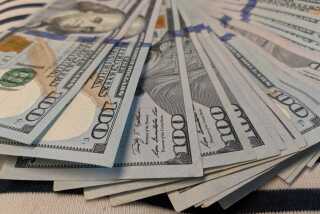Euro Reaches New High Against Dollar
- Share via
The euro broke through $1.20 for the first time in its nearly five-year history Friday, surging amid fears about the U.S. trade and budget deficits in low-key post-Thanksgiving trading.
The 12-country currency reached $1.202 in European trading, the highest since it was introduced on Jan. 1, 1999. It ended the day in New York at $1.199, surpassing the previous closing peak of $1.195 on Nov. 18.
Economists and currency strategists said short-term trading tactics and thin volume on the day after the Thanksgiving holiday played a role.
Wall Street was open for just half a day Friday.
But general fears about the massive U.S. trade and budget deficits -- factors that can undermine a country’s currency in the long run -- continued to weigh on the dollar as they have for months, analysts said.
The weakening greenback helps U.S. businesses against foreign competitors by making U.S. goods cheaper in comparison. But it makes imports, and foreign travel, more expensive for Americans.
The British pound hit a five-year high against the dollar, rising to $1.72 from $1.71 on Wednesday.
The euro rally may have been encouraged in part by comments from the German economy ministry that the current euro-dollar exchange rate gave no grounds for concern. That may have been a green light for traders to sell the dollar lower and boost the euro, some analysts said.
Also, seasonal issues may be affecting trading.
To finance its deficits, “the United States needs capital inflows,” said Robert Sinche, global head of currency research with Citibank in New York. “We know that in the second half of December there is precious little capital flow,” and that will disadvantage the dollar.
“Investors have been positioning themselves over the past week or so for what they expect will be a weak dollar during the year-end period,” Sinche said.
Nikolaus Keis, an economist at HVB Group in Munich, said the dollar could recover a bit on stronger U.S. economic news early in 2004. But he sees the euro at $1.25 by the end of next year.
Another factor that has weighed on the dollar in recent days was the decision by the Bush administration to impose trade restrictions on imports of Chinese textiles, leading to fears of trade wars that could result in retaliatory selling of U.S. securities by foreign investors.
Many observers suspect that the administration, despite its reiteration that it has a strong-dollar policy, doesn’t mind the dollar’s fall because it can help U.S. manufacturers.
On the other side of the Atlantic, the euro’s rise has raised fears that it might undermine the continent’s economic recovery just as it gets started, by making European goods more expensive abroad.
Even as the dollar sinks against many currencies, the Mexican peso is hitting new lows against the buck, on worries about the Mexican economy.
The peso hit a record low of 11.38 per dollar on Friday.
More to Read
Inside the business of entertainment
The Wide Shot brings you news, analysis and insights on everything from streaming wars to production — and what it all means for the future.
You may occasionally receive promotional content from the Los Angeles Times.








